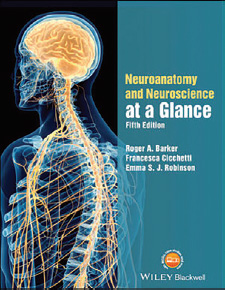This book is part of a series of books, providing a quick review of numerous medical science topics including Anatomy, Cardiology, Obstetrics and Urology ‘at a glance’. This one covers basic, or fundamental, Neuroanatomy and Neuroscience, as well as giving a brief overview of some common clinical conditions as they relate to the biological systems covered. As with the rest of the books in the ‘at a glance’ series, this book is well organised into parts, which are further subdivided into chapters. Each chapter is laid out in only two pages, with the first page containing useful cartoon illustrations of the organisation or pathways important to that chapter, and the second page briefly explaining the main concepts. I found the illustrations particularly useful; they helped me to summarise the main ideas and therefore make it easier to digest the text, as well as other resources offered.
Each page finishes with a very short ‘did you know’ section which describes an interesting fact that relates to that section. For example, one fact which I found particularly interesting was that eating chocolate causes the release of endorphins, which reduce pain and may cause people to get addicted to eating chocolate, much like opioids. I wonder if I suffer from this addiction myself!
The book comes with a subscription to online resources which contain multiple-choice questions and key revision points. Some questions and answers are also found at the end of the book which I found to be a useful way periodically to check my understanding.
I think this book offers a great foundation, upon which further knowledge can be built. As an undergraduate student, I have found using this book an effective signposting exercise as to unfamiliar concepts, before exploring further into the detail by using other more in-depth books or other resources. This book covers the most important topics in Neuroanatomy and Neuroscience, but only really touches the surface, and so I recommend that the reader does not solely rely on this resource, but rather, use it as an addition to other more in-depth resources. Although aimed at medical students, I believe this book can also benefit postgraduates and even senior clinicians, who may have moved on from the fundamental neurosciences a while ago but who also may be involved in undergraduate education. This book gives a great backbone of topic areas to cover for students.
Christmas has just passed and maybe this book is a bit serious for a Festive Season present. However, it could be a nice, reasonably priced, New Year gift from senior clinicians working in the neurosciences, to relations of theirs going through medical school, or undertaking similar studies.

